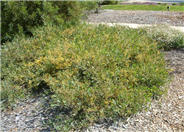
Common name:Allepo Pine
Botanical name:Pinus halepensis
The Pinus halepensis exhibits moderate growth to 30' or more, with an open, irregular crown. Mature trees have horizontal spreading branches, 20' wide and more. The needles light green in color, with a length of 2.5"- 4". Flowers are insignificant. Cones appear on the tree after a few years, rounded and oval shaped, about 3" long. Allepo Pine prefers full sun and low watering, although it will drop its needles if water stressed.

Common name:Rosemary
Botanical name:Rosmarinus officinalis
Rosemary is hardy in full sun areas where winter temperatures do not drop below 10 degrees F. They can be grown in a clay pot with well-drained, porous soil in bright indoor light, and will also flourish on the backporch in spring, summer and fall. Its beautiful, slowly trailing stems and shiny slender leaves are perfect for showing off the small, light blue flowers that blossom in the summer. -Holland WIldflower Farm

Common name:California Sagebrush
Botanical name:Artemisia californica
The California sagebrush is an evergreen medium sized, gray green aromatic shrub. The foliage has wispy soft texture.This shrub is native to CA, is drought tolerant, and attracts butterflies. This is a highly combustible plant. ~Cornflower Farms

Common name:Prostrate or Spreading Acacia
Botanical name:Acacia redolens 'Prostrata'
This is a fast growing, drought tolerant groundcover growing no higher than 3' and spreading 12 to 15' wide. The leaves are gray green; it has yellow flowers from February to April.

Common name:Lindheimer's Muhly
Botanical name:Muhlenbergia lindheimer
Native to Mexico and Texas this stunning clump forming grass is winter dormant grass in cold climates, but usually semi-deciduous in mild climates. From the fall into winter emerge the 5 ft tall upright flower inflorescence, that rise well above the blue-gray foliage. The flowers are at first purple then mature to a gray color. Best in full sun with regular watering but will tolerate drought and light shade. -Randy Baldwin
San Marcos Growers
| Designer: Anon | Large Hillside |
Photographer: GardenSoft |
Soils and Compost:
Physical weed control, including mulching, or hand removal protects the watershed from harmful chemicals.
Water Saving Tip:
Please join us on garden tours of homes in the Santa Clarita Valley.
Integrated Pest Management:
Drip and other smart irrigation delivers water directly to roots, allowing no excess water for weeds.
